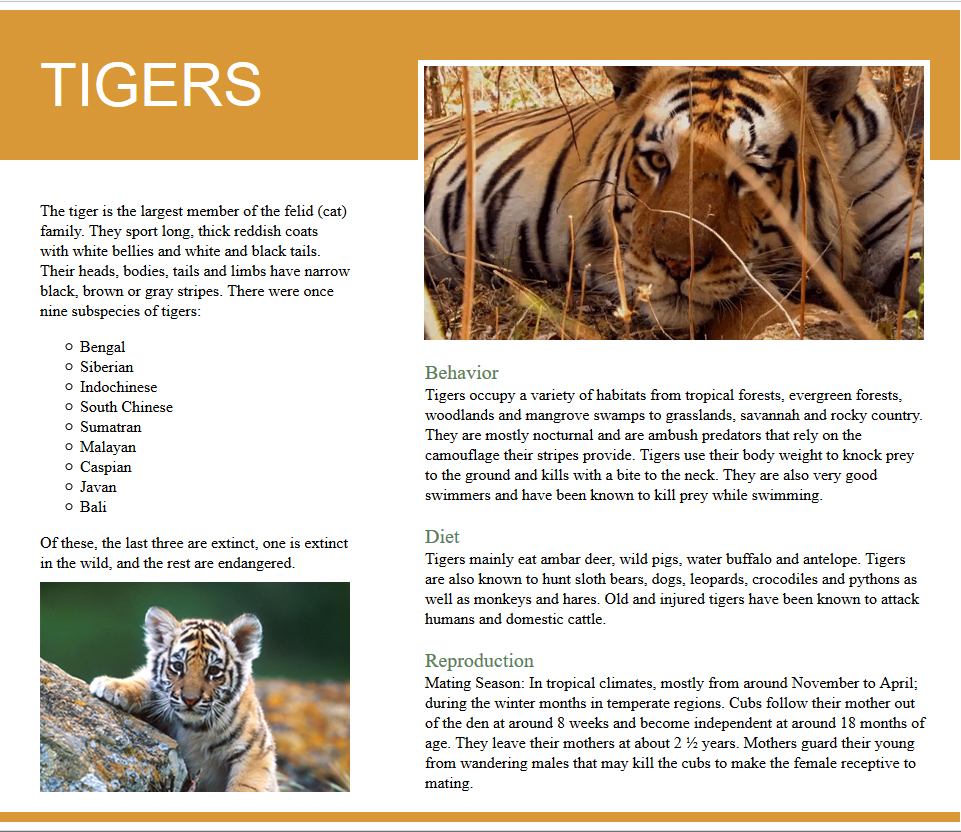The goal of the practical part is to teach you how to work independently, without my (or anybody’s) help, which is eventually the only way to work for a web designer. At this point you have more than enough knowledge to build this page
You can use handouts, textbook, any cheat sheets or any resources on the Internet;
- You will create a webpage, using the picture below as a guide.
- Your finished webpage has to resemble the image that you see here almost completely, about 95%:
(experiment with the positioning of elements until it looks right) - The test files have to be uploaded onto your dropbox
1. Create a folder called “Tiger”. Create an HTML file, name it index.html and save it into that folder.
Do not forget to save your file every several minutes while working on the practical part
You will use 2 images (download and put them into the folder "Tiger"):
Tiger (don’t worry, he will not bite you)
Tiger Cub
2. Do your best to properly use the CSS and HTML and make them neat and well-written:
- You will have to use id and class selectors, positioning (relative, absolute, etc.), border, margin, padding, float and clear float, etc.
- Do not forget about CSS Reset and *{ box-sizing:border-box;}
- Very important! Special instructions:
1. When positioning the word "TIGER", do not use margins for it, rather use padding for header, or some other way.
2. Avoid using paragraphs at this time; to format the text, use <span> tags
3. Use internal CSS (not external). You can use inline CSS if needed.
4. Some parameters that you need to apply :
- The whole page has to be in the middle of the browser
- The wrapper, header and footer width is 960px. The wrapper height doesn't matter
- The header height is 150px
- The footer height is 10px
- The header and footer color is #d99837
- The headline "TIGER" font size is 60px, color white, preferably sans-serif
- Subheadings font size is 20px, color is #588058
- List style - circles
- Text to copy is under the picture

TEXT TO COPY:
The tiger is the largest member of the felid (cat) family. They sport long, thick reddish coats with white bellies and white and black tails. Their heads, bodies, tails and limbs have narrow black, brown or gray stripes. There were once nine subspecies of tigers:
Bengal
Siberian
Indochinese
South Chinese
Sumatran
Malayan
Caspian
Javan
Bali
Of these, the last three are extinct, one is extinct in the wild, and the rest are endangered.
Behavior
Tigers occupy a variety of habitats from tropical forests, evergreen forests, woodlands and mangrove swamps to grasslands, savannah and rocky country. They are mostly nocturnal and are ambush predators that rely on the camouflage their stripes provide. Tigers use their body weight to knock prey to the ground and kills with a bite to the neck. They are also very good swimmers and have been known to kill prey while swimming.
Diet
Tigers mainly eat ambar deer, wild pigs, water buffalo and antelope. Tigers are also known to hunt sloth bears, dogs, leopards, crocodiles and pythons as well as monkeys and hares. Old and injured tigers have been known to attack humans and domestic cattle.
Reproduction
Mating Season: In tropical climates, mostly from around November to April; during the winter months in temperate regions. Cubs follow their mother out of the den at around 8 weeks and become independent at around 18 months of age. They leave their mothers at about 2 ½ years. Mothers guard their young from wandering males that may kill the cubs to make the female receptive to mating.